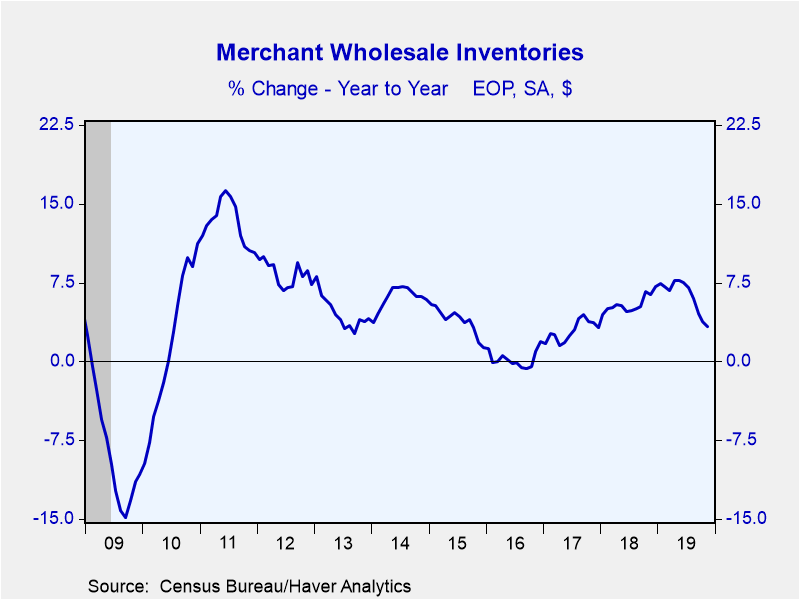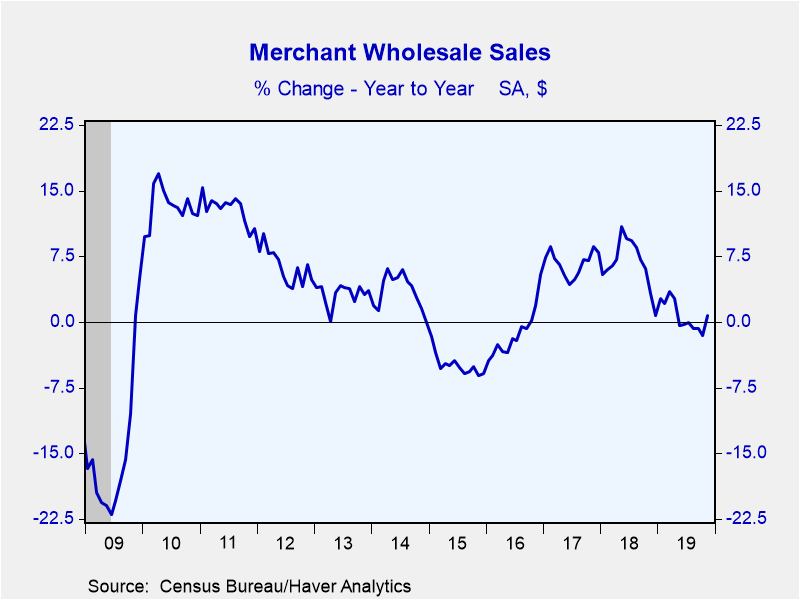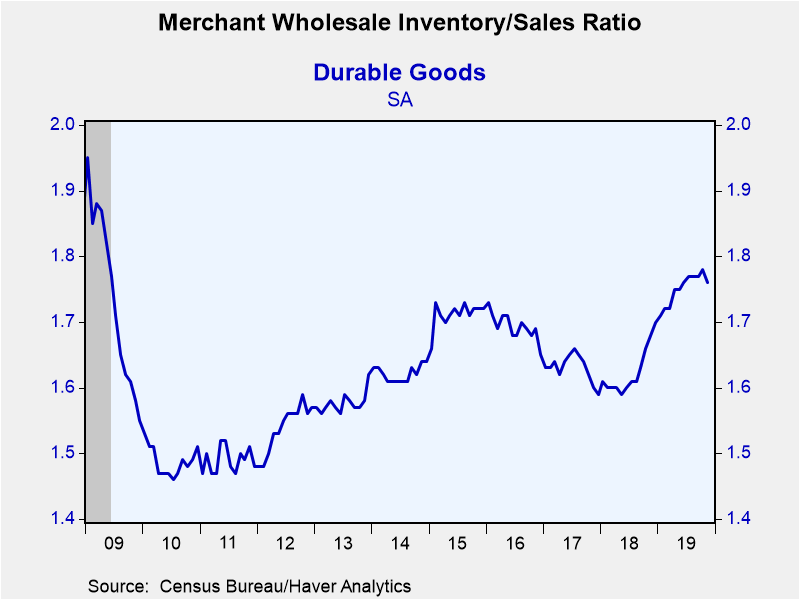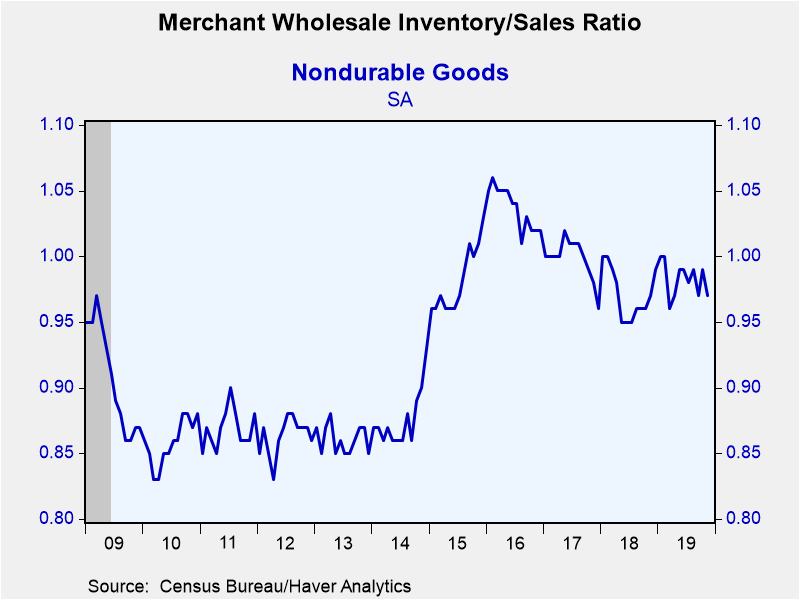 Global| Jan 10 2020
Global| Jan 10 2020Wholesale Inventories Decline as Sales Jump
Summary
Wholesale inventories edged down 0.1% in November (3.3% year-over-year), following an unrevised 0.1% gain in October. The Informa Global Markets Survey anticipated a 0.1% rise in November. Wholesale inventory swings can have a [...]
Wholesale inventories edged down 0.1% in November (3.3% year-over-year), following an unrevised 0.1% gain in October. The Informa Global Markets Survey anticipated a 0.1% rise in November. Wholesale inventory swings can have a meaningful impact on GDP. In the second quarter inventories provided a 0.9 percentage point drag on GDP growth, while in the third quarter they had little impact.
Durable goods inventories decreased 0.3% (+3.4% y/y) in November after a 0.4% decline in October. Machinery inventories, the largest sector, were down 0.3% (6.2% y/y), while vehicles, the second largest, fell 1.1% (+4.9% y/y). Electrical equipment edged up 0.1% (3.0% y/y). Inventories of nondurable goods gained 0.3% (3.1% y/y) after rising 0.9% in October. Drug inventories, which make up a quarter of nondurable inventories, gained 1.1% (5.7% y/y). Groceries, the second largest category, were up 0.9% (4.3% y/y).
Wholesale sales rebounded 1.5% during November (0.8% y/y) more than making up for the 1% decline in the previous two months. The Action Economics Forecast Survey looked for a 0.4% gain in November.
Durable goods sales rose 0.9% (-1.1% y/y) after a 1.2% decrease. Electrical equipment, the largest sector, grew 1.0% (-2.9% y/y). Professional and commercial equipment, which includes computers, declined 1.1% (-0.7% y/y). Wholesale vehicle sales jumped 4.5% (3.0% y/y) after falling 5.0% in the prior two months. Nondurable product sales rose 2.0% (2.6% y/y) after a 0.6% loss. Petroleum products jumped 6.6% (3.2% y/y), likely the result of higher oil prices. Drug sales, which vie with petroleum to be the largest category of nondurable sales, were up 0.3% (4.5% y/y) while groceries gained 0.5% (4.6% y/y).
The inventory-to-sales (I/S) ratio at the wholesale level declined to 1.35 in November from 1.37. The I/S ratio has been range-bound during 2019 after rising during the second half of last year. The durable goods I/S ratio decreased to 1.76. Last month's reading of 1.78 was the highest since the end of the Great Recession. The motor vehicles ratio fell to 1.73 from last month's ten year high of 1.83. The I/S ratio for nondurable goods decreased to 0.97.
The wholesale trade figures and oil prices are available in Haver's USECON database. The expectations figure for inventories is contained in the MMSAMER database. Expectations for sales are in the AS1REPNA database.
| Wholesale Sector - NAICS Classification (%) | Nov | Oct | Sep | Nov Y/Y | 2018 | 2017 | 2016 |
|---|---|---|---|---|---|---|---|
| Inventories | -0.1 | 0.1 | -0.7 | 3.3 | 7.1 | 3.3 | 1.9 |
| Sales | 1.5 | -0.9 | -0.1 | 0.8 | 6.7 | 6.7 | -1.3 |
| I/S Ratio | 1.35 | 1.37 | 1.36 | 1.32 (Nov '18) | 1.29 | 1.30 | 1.35 |
Gerald D. Cohen
AuthorMore in Author Profile »Gerald Cohen provides strategic vision and leadership of the translational economic research and policy initiatives at the Kenan Institute of Private Enterprise.
He has worked in both the public and private sectors focusing on the intersection between financial markets and economic fundamentals. He was a Senior Economist at Haver Analytics from January 2019 to February 2021. During the Obama Administration Gerald was Deputy Assistant Secretary for Macroeconomic Analysis at the U.S. Department of Treasury where he helped formulate and evaluate the impact of policy proposals on the U.S. economy. Prior to Treasury, he co-managed a global macro fund at Ziff Brothers Investments.
Gerald holds a bachelor’s of science from the Massachusetts Institute of Technology and a Ph.D. in Economics from Harvard University and is a contributing author to 30-Second Money as well as a co-author of Political Cycles and the Macroeconomy.









